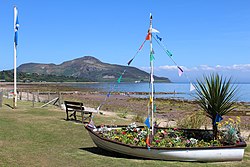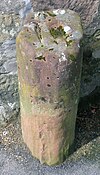Whiting Bay: Difference between revisions
Created page with "{{Infobox town |county=Buteshire |gaelic= Eadar Dhà Rubha |picture= Floral Display & Beach, Whiting Bay (geograph 3593640).jpg |picture captiion = Floral display and beach, ..." |
No edit summary |
||
| Line 13: | Line 13: | ||
|constituency=North Ayrshire and Arran | |constituency=North Ayrshire and Arran | ||
}} | }} | ||
[[File:Glenashdale_Falls.jpg| | [[File:Glenashdale_Falls.jpg|right|thumb|150px|Glenashdale Falls]] | ||
[[File:Whiting Bay milestone.jpg|left|thumb| | [[File:Whiting Bay milestone.jpg|left|thumb|100px|Old milestone in Whiting Bay]] | ||
'''Whiting Bay''' | '''Whiting Bay''' is a village located on the Isle of [[Arran]] in [[Buteshire]], and also the name of the bay indenting the island's eastern coast here. The name 'Whiting Bay' is thought to originate from "Viking" Bay. | ||
The bay, in the southern part of the island, is a shallow bay, looking out on the [[Firth of Clyde]]. | |||
The village is approximately three miles south of the village of [[Lamlash]]. Whiting Bay is the third largest village on the island (after Lamlash and [[Brodick]]) and was once the site of the longest pier in Scotland. Like all villages on Arran, tourism is important to the village. | |||
The spectacular [[Glenashdale Falls]] with a nearby Iron Age fort and a prehistoric burial site the "Giants' Graves" are an easy walk from the village. | The spectacular [[Glenashdale Falls]] with a nearby Iron Age fort and a prehistoric burial site the "Giants' Graves" are an easy walk from the village. | ||
| Line 21: | Line 25: | ||
To the north of the village at Kings Cross Point between [[Lamlash]] and Whiting Bay is another Iron Age fort known locally as the "Viking Fort". According to local legend, this is the site where Robert the Bruce mistook farmers' fires on the mainland as the signal to launch his campaign. This site was also the location of a Viking ship burial excavated in the earlier 20th century. | To the north of the village at Kings Cross Point between [[Lamlash]] and Whiting Bay is another Iron Age fort known locally as the "Viking Fort". According to local legend, this is the site where Robert the Bruce mistook farmers' fires on the mainland as the signal to launch his campaign. This site was also the location of a Viking ship burial excavated in the earlier 20th century. | ||
Information about the history of Whiting Bay and of other sites on the Isle of Arran is available through the [http://www.arranmuseum.co.uk Arran Heritage Museum] | Information about the history of Whiting Bay and of other sites on the Isle of Arran is available through the [http://www.arranmuseum.co.uk Arran Heritage Museum]. | ||
Whiting Bay has a population of 680 people according to the 2011 UK Census. | Whiting Bay has a population of 680 people according to the 2011 UK Census. | ||
== Outside links == | == Outside links == | ||
{{commons | {{commons}} | ||
*[http://walking.visitscotland.com/walks/southscotland/212742 Glenashdale Falls] | *[http://walking.visitscotland.com/walks/southscotland/212742 Glenashdale Falls] | ||
*[http://www.arranmuseum.co.uk/ Arran Heritage Museum] | *[http://www.arranmuseum.co.uk/ Arran Heritage Museum] | ||
[[Category:Bays of Buteshire]] | |||
Latest revision as of 07:37, 2 July 2016
| Whiting Bay Gaelic: Eadar Dhà Rubha | |
| Buteshire | |
|---|---|

| |
| Location | |
| Grid reference: | NS045255 |
| Location: | 55°29’6"N, 5°5’38"W |
| Data | |
| Postcode: | KA27 |
| Dialling code: | 01770 |
| Local Government | |
| Council: | North Ayrshire |
| Parliamentary constituency: |
North Ayrshire and Arran |


Whiting Bay is a village located on the Isle of Arran in Buteshire, and also the name of the bay indenting the island's eastern coast here. The name 'Whiting Bay' is thought to originate from "Viking" Bay.
The bay, in the southern part of the island, is a shallow bay, looking out on the Firth of Clyde.
The village is approximately three miles south of the village of Lamlash. Whiting Bay is the third largest village on the island (after Lamlash and Brodick) and was once the site of the longest pier in Scotland. Like all villages on Arran, tourism is important to the village.
The spectacular Glenashdale Falls with a nearby Iron Age fort and a prehistoric burial site the "Giants' Graves" are an easy walk from the village.
To the north of the village at Kings Cross Point between Lamlash and Whiting Bay is another Iron Age fort known locally as the "Viking Fort". According to local legend, this is the site where Robert the Bruce mistook farmers' fires on the mainland as the signal to launch his campaign. This site was also the location of a Viking ship burial excavated in the earlier 20th century.
Information about the history of Whiting Bay and of other sites on the Isle of Arran is available through the Arran Heritage Museum.
Whiting Bay has a population of 680 people according to the 2011 UK Census.
Outside links
| ("Wikimedia Commons" has material about Whiting Bay) |
